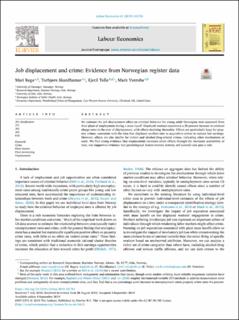| dc.contributor.author | Rege, Mari | |
| dc.contributor.author | Skarðhamar, Torbjørn | |
| dc.contributor.author | Telle, Kjetil | |
| dc.contributor.author | Votruba, Mark | |
| dc.date.accessioned | 2020-05-04T11:23:13Z | |
| dc.date.available | 2020-05-04T11:23:13Z | |
| dc.date.created | 2019-09-28T15:30:45Z | |
| dc.date.issued | 2019-09 | |
| dc.identifier.citation | Rege, M., Skardhamar, T., Telle, K., & Votruba, M. (2019). Job displacement and crime: Evidence from Norwegian register data. Labour Economics, 61, 101761. | en_US |
| dc.identifier.issn | 0927-5371 | |
| dc.identifier.uri | https://hdl.handle.net/11250/2653196 | |
| dc.description.abstract | We estimate the job displacement effect on criminal behavior for young adult Norwegian men separated from their plant of employment during a mass layoff. Displaced workers experience a 20 percent increase in criminal charge rates in the year of displacement, with effects declining thereafter. Effects are particularly large for property crimes, consistent with the idea that displaced workers turn to acquisitive crimes to replace lost earnings. However, effects are also sizable for violent and alcohol/drug-related crimes, indicating other mechanisms at work. We find strong evidence that displacement increases crime effects through the increased availability of time, and supportive evidence that psychological factors (mental distress, self-control) also play a role. | en_US |
| dc.language.iso | eng | en_US |
| dc.publisher | Elsevier | en_US |
| dc.rights | Navngivelse-Ikkekommersiell-DelPåSammeVilkår 4.0 Internasjonal | * |
| dc.rights.uri | http://creativecommons.org/licenses/by-nc-sa/4.0/deed.no | * |
| dc.subject | Crime | en_US |
| dc.subject | Kriminalitet | en_US |
| dc.subject | Unemployment | en_US |
| dc.subject | Arbeidsledighet | en_US |
| dc.subject | Layoffs | en_US |
| dc.subject | Oppsigelser | en_US |
| dc.subject | Permitteringer | en_US |
| dc.subject | Criminal behavior | en_US |
| dc.title | Job displacement and crime: Evidence from Norwegian register data | en_US |
| dc.type | Peer reviewed | en_US |
| dc.type | Journal article | en_US |
| dc.description.version | publishedVersion | en_US |
| dc.rights.holder | 0927-5371/©2019 The Authors. Published by Elsevier B.V. This is an open access article under the CC BY-NC-ND license.
( http://creativecommons.org/licenses/by-nc-nd/4.0/ ) | en_US |
| dc.subject.nsi | VDP::Samfunnsvitenskap: 200::Økonomi: 210 | en_US |
| dc.subject.nsi | VDP::Samfunnsvitenskap: 200::Kriminologi: 350 | en_US |
| dc.source.pagenumber | 15 sider. | en_US |
| dc.source.volume | 61 | en_US |
| dc.source.journal | Labour Economics | en_US |
| dc.source.issue | December 2019 | en_US |
| dc.identifier.doi | 10.1016/j.labeco.2019.101761 | |
| dc.identifier.cristin | 1730630 | |
| dc.relation.project | Norges Forskningsråd: 160965/V10 | en_US |
| dc.relation.project | National Science Foundation: (SES-0417418) | en_US |
| cristin.ispublished | true | |
| cristin.fulltext | postprint | |
| cristin.fulltext | original | |
| cristin.qualitycode | 2 | |

